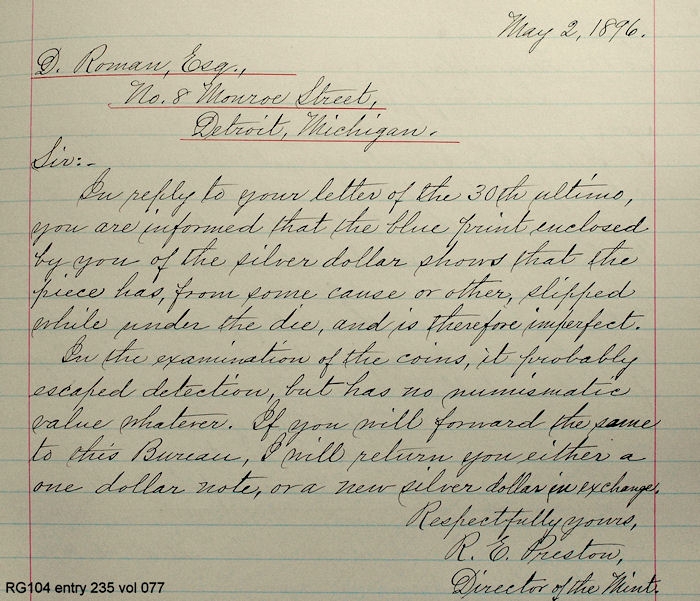Error coins once had "...no numismatic value whatever."
 RogerB
Posts: 8,852 ✭✭✭✭✭
RogerB
Posts: 8,852 ✭✭✭✭✭
How things have changed. This is one of many archive letters referring to various kinds of error coins that the US Mint was asked to evaluate. Standard procedure was to replace the defective coin with another of the same denomination.
3
Comments
R.E. Preston, "but has no numismatic value, whatever."
R.E. Preston, sneaking it in. I will give you a silver dollar or a buck, in exchange for the error.
Jeez, what a deal.
I wish I could see the coin being described in the letter!
Fascinating how things change with fashion. Remember when everything had to be shiny and toning was a bad thing?
Here's a warning parable for coin collectors...
Me too. Sounds like an off center strike, though we'll never know.
That sounds logical. Was "slipped" used for off center strikes? Is there any documentation that might tell us the meaning for the term?
Dear Langbord family,
The ten 1933 St. Gaudens Double Eagles have no numismatic value whatsoever. Please return them posthaste and we will send you two freshly printed ben franklins to make things right. If we do not hear from you immediately, our SWAT team will be right over to break down your doors, and you and your extended family will be treated like you are a terror cell planning another 911.
Good day.
Indian Head $10 Gold Date Set Album
Very interesting. Thanks for posting it.
Interesting Roger... I am continually amazed at what you find in the archives.... Cheers, RickO
Cheers, RickO
and yes dpoole.... I do remember when tarnish was bad... still is IMO...
Who paid the postage or shipping for the returns?
The Mysterious Egyptian Magic Coin
Coins in Movies
Coins on Television
Great penmenshm
Great handwriting
"Who paid the postage or shipping for the returns?"
Each paid their own on small items like this. (When banks ordered coins shipped to them, the bank paid the insured parcel post rate.)
They sure don't make them the way they used to. ( men / or dollars ) .
And a joyous holiday season to all.
``https://ebay.us/m/KxolR5
Merchants and banks routinely rejected all suspicious coins and paper currency. Thus, a defective (or error) coin might have been a total loss for the holder - and a considerable financial burden, too. Many workmen earned just $2 per day,